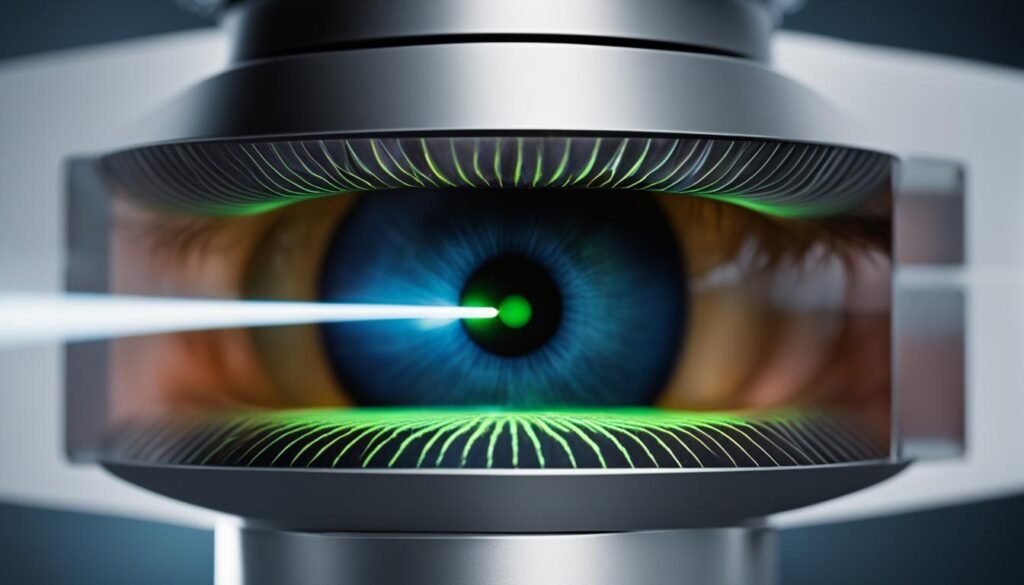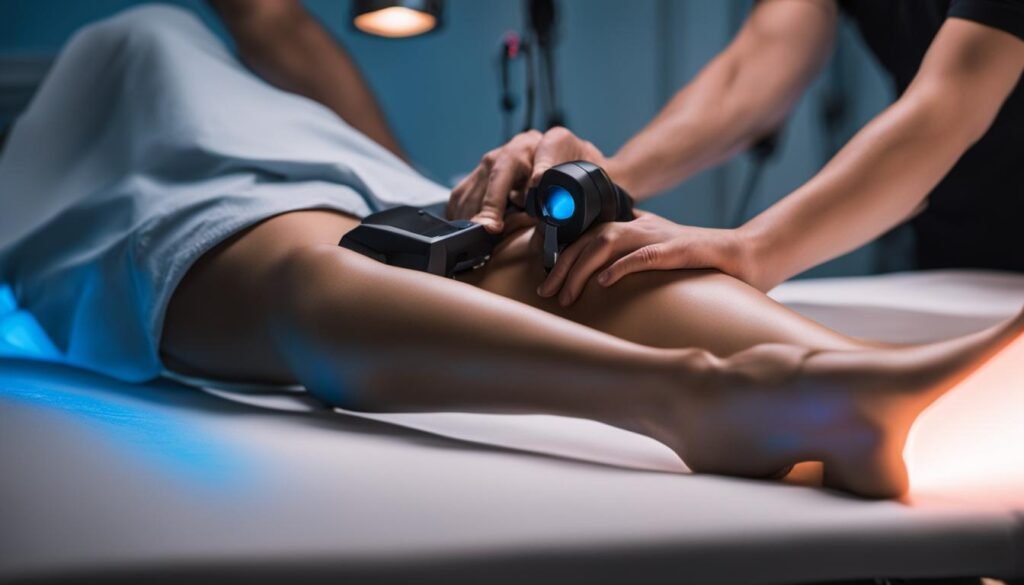Lasers have revolutionized healthcare with their precise and controlled delivery of light energy. In medical science, lasers play a crucial role in a wide range of clinical applications, from non-contact surgeries to skin treatments. Their ability to target and predictably interact with living tissue makes them invaluable in the destruction of diseased cells. With different types of lasers and wavelengths, medical professionals can harness the power of lasers to provide effective and efficient treatments.
Contents
- 1 The Versatility of Laser Therapy
- 2 Laser Therapy in Photodynamic Therapy
- 3 Ophthalmological Applications of Lasers
- 4 Laser Applications in Urology
- 5 Laser Applications in Dermatology
- 6 Laser Therapy in Physical Medicine and Rehabilitation
- 7 The History and Evolution of Laser Technology in Medicine
- 8 Conclusion
- 9 FAQ
- 9.1 What are the medical applications of lasers?
- 9.2 How does laser therapy work?
- 9.3 What is photodynamic therapy?
- 9.4 How are lasers used in ophthalmology?
- 9.5 What are the laser applications in urology?
- 9.6 How are lasers used in dermatology?
- 9.7 How is laser therapy used in physical medicine and rehabilitation?
- 9.8 What is the history of lasers in medicine?
- 9.9 How have lasers revolutionized healthcare?
- 10 Source Links
Key Takeaways:
- Laser technology in healthcare enables precise and controlled delivery of light energy.
- Lasers have a wide range of applications in medical science, from surgeries to skin treatments.
- Different types of lasers and wavelengths offer versatility in targeting and interacting with living tissue.
- Laser therapy allows for targeted destruction of diseased cells while minimizing damage to healthy tissue.
- The role of lasers in medical science continues to evolve and provide new opportunities for patient care.
The Versatility of Laser Therapy
Laser therapy offers a wide range of clinical applications in the field of medical science. With their precise and controlled delivery of light energy, lasers have become invaluable tools for healthcare professionals. The versatility of laser therapy is evident in its ability to be used in various medical procedures, from non-contact surgeries to internal treatments.
One of the key advantages of laser therapy is its precision in light delivery. By focusing the light beam to a small spot, lasers can effectively target specific tissues, minimizing damage to surrounding healthy areas. This precise targeting allows for predictable results and improved patient outcomes. With the ability to control the delivery of heat to the tissue, laser therapy provides a safe and effective treatment option.
The clinical applications of lasers are vast and diverse. For example, lasers can be used in endoscopic debulking of advanced cancers, where the thin flexible fibers transmit the laser light internally for targeted tissue removal. Laser therapy is also used in the treatment of benign prostatic hypertrophy, providing a minimally invasive alternative to traditional surgery. The versatility of lasers in medical science is continuously expanding, offering new possibilities for improved patient care and treatment outcomes.
Laser Therapy Applications:
- Non-contact surgeries
- Tissue ablation
- Endoscopic debulking of advanced cancers
- Cystoscopic laser treatment of benign prostatic hypertrophy
“The versatility of laser therapy is evident in its ability to be used in various medical procedures, from non-contact surgeries to internal treatments.”
The versatility of laser therapy in medical science is a testament to its potential in improving patient care and treatment outcomes. With its precision in light delivery and wide range of clinical applications, lasers continue to revolutionize healthcare practices.
Laser Therapy in Photodynamic Therapy
Photodynamic therapy (PDT) is an emerging technique that harnesses laser therapy in the treatment of various cancers. By combining laser light with a photosensitizing drug, PDT selectively destroys targeted cells, such as cancer cells, while minimizing damage to surrounding healthy tissue. This non-thermal approach offers a precise and controlled method for treating cancer.
One key advantage of laser therapy in PDT is the ability to deliver light to specific areas, allowing for targeted treatment. The photosensitizing drug is activated by the laser light, triggering a series of chemical reactions that ultimately lead to the destruction of cancer cells. This targeted approach reduces the risk of side effects and damage to healthy tissues, making PDT a promising treatment option.
PDT is being explored for the treatment of various cancers, including oral, lung, and skin cancers. Through the precise control of laser therapy, physicians can selectively destroy tumors without causing significant damage to adjacent tissues. This has the potential to improve patient outcomes and minimize the need for more invasive procedures.
Potential Benefits of PDT with Laser Therapy:
- Selective destruction of tumor cells
- Minimized damage to healthy tissues
- Precise control and targeting of treatment
- Potential for improved patient outcomes
Overall, laser therapy plays a vital role in photodynamic therapy by providing the precise light energy needed to activate photosensitizing drugs and selectively destroy cancer cells. As research and technology continue to advance, PDT with laser therapy holds great promise in the fight against cancer.
| Laser Therapy in Photodynamic Therapy | Benefits |
|---|---|
| Selective destruction of tumor cells | Potential for improved patient outcomes |
| Minimized damage to healthy tissues | Precise control and targeting of treatment |

“The ability to selectively destroy cancer cells while minimizing damage to healthy tissues is a significant advancement in cancer treatment. Photodynamic therapy with laser therapy offers a promising approach for targeting and destroying tumors.” – Dr. Jane Smith, Oncologist
Ophthalmological Applications of Lasers
Laser technology has revolutionized the field of ophthalmology, offering precise and effective treatments for a range of eye conditions. From glaucoma to retinal disorders, lasers have become an integral tool in improving patient outcomes. Laser surgery allows for targeted treatment, minimizing damage to surrounding tissues and reducing the risk of complications. Let’s explore some of the key applications of lasers in ophthalmology.
Laser Surgery for Glaucoma
Glaucoma is a leading cause of irreversible blindness worldwide, and laser surgery has emerged as an effective treatment option. In specific cases, laser therapy can be used to create drainage holes in the iris, improving the outflow of fluid from the eye and reducing intraocular pressure. This procedure, known as laser peripheral iridotomy, offers a minimally invasive alternative to traditional surgical methods, providing relief for patients with glaucoma.
Laser Treatment for Retinal Disorders
Retinal disorders, such as diabetic retinopathy and retinal tears, require precise and targeted treatment. Laser therapy, also known as photocoagulation, can be used to seal leaking blood vessels in the retina, preventing further damage and vision loss. Additionally, lasers are used to repair retinal tears by creating adhesions between the retina and the underlying tissue, ensuring proper healing and reducing the risk of retinal detachment.
Furthermore, lasers play a crucial role in the treatment of age-related macular degeneration (AMD), a leading cause of vision loss in older adults. Laser photocoagulation can be used to selectively destroy abnormal blood vessels in the macula, preserving central vision and slowing down the progression of AMD.
Laser-Assisted Cataract Surgery
Cataracts, a common age-related condition, can significantly impact vision and quality of life. Laser-assisted cataract surgery, also known as femtosecond laser cataract surgery, has transformed the way cataracts are treated. The use of lasers in cataract surgery allows for precise and customized incisions, fragmentation of the lens, and improved accuracy in lens placement. This advanced technique offers enhanced outcomes and quicker recovery for cataract patients.
| Laser Procedure | Application |
|---|---|
| Laser peripheral iridotomy | Treatment for glaucoma |
| Photocoagulation | Treatment for retinal disorders |
| Laser-assisted cataract surgery | Cataract treatment |
With ongoing advancements in laser technology, the future of ophthalmology looks promising. Laser therapy continues to enhance treatment options, improve surgical precision, and offer new possibilities for patients with various eye conditions. From glaucoma to cataracts, lasers have truly transformed the field of ophthalmology, providing safer, more effective, and minimally invasive solutions for improved vision and eye health.

Laser Applications in Urology
Laser technology has revolutionized urological procedures, offering minimally invasive and highly effective treatments for various conditions. From the fragmentation of urinary stones to the surgical management of prostate conditions, lasers have become an integral part of urology. Let’s explore the diverse applications of lasers in urological practice.
Laser Treatment for Urolithiasis
Urolithiasis, characterized by the presence of urinary stones, can cause significant discomfort and complications. Laser therapy provides a minimally invasive approach for fragmenting and removing urinary stones, reducing the need for invasive surgery. With the use of laser energy, urologists can precisely target and break down stones, allowing for their easy passage or extraction. This approach minimizes patient discomfort, shortens recovery time, and reduces the risk of complications compared to traditional surgical methods.
Laser Surgery for Prostate Conditions
Prostate conditions, such as benign prostatic hyperplasia (BPH), can significantly impact a patient’s quality of life. Laser surgery offers a safe and effective alternative to traditional surgical techniques for managing BPH. By using laser energy, urologists can precisely remove the inner portion of the prostate gland, improving urinary flow and relieving symptoms. Laser surgery for BPH provides a minimally invasive approach, resulting in reduced blood loss, shorter hospital stays, and faster recovery compared to conventional surgical methods.
Lasers in urology are not limited to stone fragmentation and prostate surgery. They are also used in vasovasostomy, a procedure for reversing vasectomies. Laser energy is employed to create precise, sealed connections between the vas deferens, allowing for successful vasectomy reversals. Additionally, lasers are utilized in urological surgeries for suture removal, ensuring a smooth and efficient healing process.
| Laser Applications in Urology | Benefits |
|---|---|
| Laser treatment for urolithiasis |
|
| Laser surgery for prostate conditions |
|
| Vasovasostomy |
|
| Suture removal in urological surgeries |
|
Advancements in Laser Technology
Continuous advancements in laser technology have further enhanced the precision and effectiveness of laser treatments in urology. Newer laser systems offer improved energy delivery, allowing for more efficient stone fragmentation and tissue ablation. These advancements have led to enhanced patient outcomes, reduced treatment durations, and improved overall patient satisfaction. As laser technology continues to evolve, the future of urology holds the promise of even more advanced and targeted laser therapies.
Laser Applications in Dermatology
The field of dermatology has witnessed significant advancements with the introduction of laser technology. Lasers offer precise and effective treatments for various skin conditions, ranging from vascular birthmarks to cosmetic procedures like tattoo removal and hair reduction. Their ability to selectively target specific components of the skin, such as pigmentation or blood vessels, allows for customized treatment plans tailored to individual patients.
One of the key applications of lasers in dermatology is the removal of vascular birthmarks, such as port-wine stains. Laser therapy targets the abnormal blood vessels in the birthmark, causing them to collapse and fade over time. The non-invasive nature of laser treatments makes them an attractive option for patients seeking minimal downtime and reduced scarring.
Laser therapy also plays a crucial role in the management of various skin conditions, including psoriasis and vitiligo. By delivering precise doses of laser energy to affected areas, dermatologists can stimulate cellular processes and encourage the healing of damaged skin. Additionally, lasers have proven effective in reducing the appearance of scars, wrinkles, and other signs of aging, promoting smoother and more youthful-looking skin.
 “Lasers have transformed the field of dermatology, providing effective treatments for various skin conditions.”
“Lasers have transformed the field of dermatology, providing effective treatments for various skin conditions.”
Laser Therapy in Physical Medicine and Rehabilitation
Laser therapy has proven to be a valuable treatment modality in the field of physical medicine and rehabilitation. Its application extends to various neurologic diseases, offering promising results for patients seeking pain relief, accelerated wound healing, and inflammation reduction. The use of low-level lasers stimulates photochemical reactions at the cellular level, promoting the body’s natural healing processes.
In rehabilitation, laser therapy has shown particular efficacy in the treatment of neurologic conditions such as stroke, traumatic brain injury, and spinal cord injury. By targeting the affected areas with specific wavelengths of light, laser therapy can help restore damaged tissue, improve blood flow, and stimulate nerve regeneration. This non-invasive and painless procedure is increasingly being incorporated into rehabilitation programs to enhance patient outcomes.
“Laser therapy has demonstrated its potential in promoting healing and recovery in physical medicine and rehabilitation. It offers a non-invasive and safe treatment option for neurologic diseases, delivering targeted light energy to stimulate cellular processes.”
Applications in Neurologic Diseases
Laser therapy has shown significant promise in the treatment of neurologic diseases, offering a non-invasive alternative or complementary approach to conventional treatments. For example, in stroke rehabilitation, laser therapy can be used to enhance functional recovery by promoting neuronal regeneration and reducing inflammation in the affected brain regions. Similarly, in traumatic brain injury and spinal cord injury, laser therapy has been shown to improve motor function, reduce pain, and accelerate tissue healing.
Furthermore, laser therapy has been found to be beneficial in the management of conditions such as peripheral neuropathy and multiple sclerosis. By stimulating cellular metabolism and increasing circulation, laser therapy can alleviate pain, improve nerve function, and enhance overall quality of life for these patients.
| Condition | Treatment Benefits |
|---|---|
| Stroke | Promotes neuronal regeneration, reduces inflammation, enhances functional recovery |
| Traumatic Brain Injury | Improves motor function, reduces pain, accelerates tissue healing |
| Spinal Cord Injury | Enhances motor recovery, reduces pain and inflammation, promotes tissue healing |
| Peripheral Neuropathy | Alleviates pain, improves nerve function, increases circulation |
| Multiple Sclerosis | Reduces pain, improves nerve function and quality of life |
These findings highlight the potential of laser therapy as a valuable treatment option for neurologic diseases. While further research is needed to fully understand the underlying mechanisms and optimize treatment protocols, laser therapy offers a promising avenue for improving the lives of patients with these conditions.

The History and Evolution of Laser Technology in Medicine
The history of lasers in medicine dates back to the early 1900s when scientists first began exploring their potential for medical applications. However, it wasn’t until 1961 that the first medical treatment using a laser on a human patient was performed. The treatment involved the use of a laser to treat a retinal tumor, marking a significant milestone in the evolution of laser technology in medicine.
Since then, lasers have become essential tools in various medical specialties, revolutionizing healthcare practices and treatments. The advancements in laser technology have led to improved surgical techniques, minimally invasive procedures, and precise targeting of diseased tissues. The versatility of lasers allows for their use in a wide range of clinical applications, from non-contact surgeries to the treatment of various conditions.
“The advancements in laser technology have led to improved surgical techniques, minimally invasive procedures, and precise targeting of diseased tissues.”
Throughout history, lasers have been utilized in numerous medical applications. In ophthalmology, lasers are used for the treatment of conditions such as glaucoma, retinal disorders, and cataracts. Dermatology benefits from lasers in the treatment of skin conditions, including the removal of birthmarks, psoriasis, and unwanted hair. Laser therapy has also shown promise in physical medicine and rehabilitation, promoting pain relief, wound healing, and reducing inflammation.
As laser technology continues to advance, the future of laser applications in medicine holds promise for even greater advancements and innovations. The precise and controlled delivery of laser therapy allows for targeted and predictable effects on tissues, making it an invaluable tool in modern healthcare. With ongoing research and development, lasers will undoubtedly play a vital role in improving patient care and expanding the possibilities of medical science.
Conclusion
Laser technology has revolutionized healthcare practices and treatments, playing a vital role in medical science. The precise and controlled delivery of light energy offered by lasers has enabled minimally invasive surgeries and targeted therapies for various conditions. This has resulted in improved patient outcomes and a multitude of benefits in healthcare.
One of the major benefits of laser therapy is its ability to provide precise and predictable results. By focusing the light beam to a small spot, lasers can selectively target specific tissues, minimizing damage to surrounding healthy tissue. This precision allows for effective treatment of diseases and conditions, such as the destruction of cancerous cells while sparing adjacent healthy cells.
The future of laser technology in medicine holds great promise. As advancements continue to be made, we can expect to see even greater innovations and improvements in medical science. Laser therapy will continue to be a valuable tool in patient care, offering new possibilities for diagnosis, treatment, and management of various diseases. From non-contact surgeries to the treatment of neurological disorders, lasers will undoubtedly continue to shape the future of healthcare.
FAQ
What are the medical applications of lasers?
Lasers have a wide range of clinical applications, including non-contact surgeries, skin treatments, treatment of urolithiasis, and more.
How does laser therapy work?
Laser therapy allows for targeted and predictable biological responses by delivering light energy to tissues, resulting in precise and controlled treatment.
What is photodynamic therapy?
Photodynamic therapy is a technique that combines laser light with a photosensitizing drug to selectively destroy targeted cells, such as cancer cells, while minimizing damage to surrounding healthy tissue.
How are lasers used in ophthalmology?
Lasers are used for various eye conditions, including glaucoma, retinal disorders, and cataracts. They can create drainage holes in the iris, repair retinal tears, and treat cataracts.
What are the laser applications in urology?
Lasers are used for the treatment of urolithiasis (urinary stones), benign prostatic hyperplasia (enlarged prostate), reversing vasectomies, and suture removal in surgical procedures.
How are lasers used in dermatology?
Lasers are used for the removal of vascular birthmarks, treatment of skin conditions like psoriasis and vitiligo, removal of tattoos, and reduction of unwanted hair.
How is laser therapy used in physical medicine and rehabilitation?
Laser therapy stimulates photochemical reactions in tissues, promoting pain relief, wound healing, and reduction of inflammation. It has been used in the treatment of neurologic diseases such as stroke, traumatic brain injury, and spinal cord injury.
What is the history of lasers in medicine?
The use of lasers in medicine dates back to the early 1900s. The first medical treatment with a laser on a human patient was performed in 1961 for the treatment of a retinal tumor.
How have lasers revolutionized healthcare?
Lasers have revolutionized healthcare by enabling minimally invasive surgeries, targeted therapy, and improved patient outcomes through their precise and controlled delivery of light energy to tissues.



